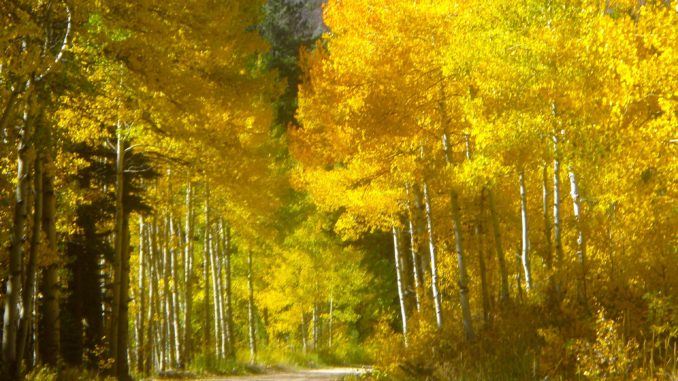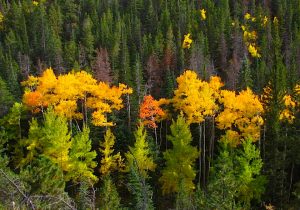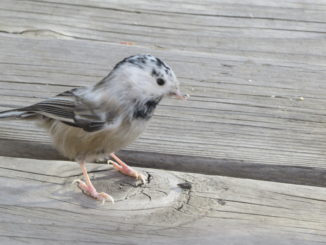
By Sally Roth
North Forty News
Oh my gosh, was I a snob when I first moved to the Front Range!
Not snobby about handbags or marble counters or fancy cars or the other usual things folks feel proud of.
Nope, for me it was fall color.
“Poor Westerners,” I thought, condescendingly. “Must be so boring in fall. No flaming red maples or oaks. No bright orange sassafras, no burgundy ash trees. Just plain old yellow, and nothing but yellow.”
Even when new friends and neighbors tried to tell me how gorgeous fall aspens were, it went in one ear and out the other. Heck, I even dismissed the claims of aspen beauty from my husband, a near-native of the very same canyon in which we still live.
“I guess if yellow is all you have, you learn to love yellow,” I said to him, my haughty nose in the air.
Hey, I’d seen fall aspens on calendars and puzzle boxes. Pretty? Sure. But nowhere near as stunning as the hardwood forests I’d known all my life.
Then I got my comeuppance.
As the weather cooled that first fall, the aspens started to turn color. At first it was only a few groves.

Two different clonal colonies of aspens—one already peaking, one a few days behind. The record aspen grove, all exact genetic replicas, or clones, covers about 200 acres in Fishlake National Forest of south-central Utah. Estimated to be about 80,000 years old, the colony even has a name: “Pando.”
“Why don’t they all turn at once?”
“Because they’re different families,” explained my patient husband, who by this time was used to my newcomer questions about how Nature works here.
That bunch on one side of the driveway, the ones already beginning to glow? “That’s the earliest family.”
Fifty feet away, a different batch were still deep green. “They’re always the latest. Latest to get catkins, latest to leaf out, latest to go gold.”
Quaking aspens (Populus tremuloides) spread into colonies via roots. As soon as one fast-growing aspen seedling gets a roothold in the openings the trees prefer—a natural meadow, a creek, a canyon, anywhere there’s a bit more moisture than the dry hillsides where less thirsty pines thrive—it spreads its good fortune as fast as it can, sending out roots in every direction to sprout more trees.
That makes each colony of aspens a family. A family of one, that is, because each tree that springs up from the same roots is an exact clone, genetically identical to the others.
That first fall, eight years ago, I soaked in the golden glory of the aspens around our house and along the road and on rambles to the high meadow. Even on gray days, the outside world glowed with aspen sunshine.
But it wasn’t until we took a drive through the mountains that I really got it.
Every mountainside was splashed with gold—gold that poured down the folds of the hills, that stood out like a spotlight against the evergreens, that ignited the somber green pines with big daubs of glowing yellow.
I oohed and ahhed as if I were at a fireworks show. And not once did I yearn for red maples or oaks. This was a whole different kind of beauty, as if the sun had come to earth.
The smell was way different, too.
Instead of the earthy humus aroma of a hardwood forest in autumn, what I smelled was…aspirin.
Next time you open a bottle of aspirin—the old-fashioned round white pills, not capsules, not Tylenol—stick your nose in and take a sniff.
Notice that sour, tangy smell?
That’s the signature scent of salicylic acid, the pain-killing ingredient in those handy white pills. It’s synthesized now in laboratories, but it started with trees.
Willows have salicylic acid in spades. So do aspens.
Concentrated in the inner bark, the acid spreads out into every bit of the trees, helping their growth and triggering other responses that keep them safe from pests and diseases.
And in fall, on those leaf-peeping drives or in any aspen grove you stroll through, the tangy smell of aspirin is thick in the air.
Aspen season usually peaks about the third to fourth week of September, with some color lingering into early October, depending on elevation—and on the timetable of the particular “family” of trees.
Those poor Easterners. They have no idea what they’re missing.
Support Northern Colorado Journalism
Show your support for North Forty News by helping us produce more content. It's a kind and simple gesture that will help us continue to bring more content to you.
BONUS - Donors get a link in their receipt to sign up for our once-per-week instant text messaging alert. Get your e-copy of North Forty News the moment it is released!
Click to Donate


